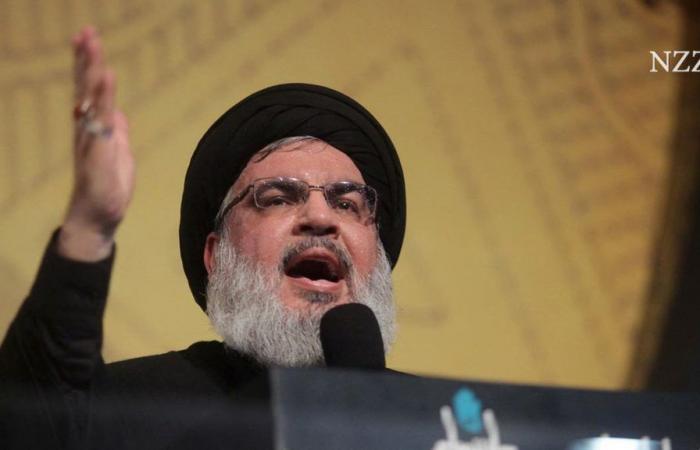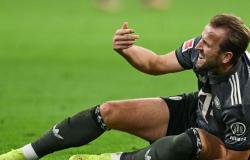The long-time Hezbollah leader has formed the strongest militia in the Middle East from a guerrilla force. Now he has been killed in an Israeli airstrike.
Hezbollah confirmed the death of its leader Hassan Nasrallah on Saturday.
Stringer / Reuters
A little over a week ago, just two days after Israel blew up thousands of pagers in the southern Beirut suburb of Dayhieh, Hezbollah leader Hassan Nasrallah appeared before the cameras. With a turban and a carefully groomed beard, he announced against a blood-red background that he wanted to continue fighting. The powerful leader appeared almost as usual: charismatic, confident and composed.
It was supposed to be his last speech. Yesterday evening, Hassan Nasrallah was killed in a massive Israeli airstrike on his militia’s stronghold in Beirut. Israel’s army confirmed the death of the Hezbollah leader early Saturday afternoon. A little later, the militia itself reported this in a press release.
“They killed God”
By killing Nasrallah, Israel may have delivered a devastating blow to Hezbollah. Because the 64-year-old was more than just its general secretary. He was the spiritual leader of a movement whose power reached far beyond tiny Lebanon. For many Shiites, Nasrallah was a mixture of prophet and saint. “They killed their God,” said a Christian Lebanese himself last night, shortly after the first rumors about the death of the Hezbollah leader began circulating.
For many of Israel’s opponents, Nasrallah was the most important leader in their fight against the great enemy. He not only headed the most powerful militia in the Middle East, but was also one of the most important figures in the Iranian-controlled “Axis of Resistance” – which stretches from Tehran via Damascus to Yemen. Some observers even compare his influence to that of Iranian religious leader Ali Khamenei. His death will therefore shock the entire Middle East.
Nasrallah was born in 1960 into a Shiite family in Beirut’s Burj Hammoud neighborhood. Later, in the turmoil of the Lebanese civil war, he fled to southern Lebanon, where he joined the then emerging Shiite Amal movement. In the early 1980s he was one of the co-founders of Hezbollah – the radical, Islamist militia that was founded in the broken civil war of Lebanon under Iranian supervision and became increasingly powerful over the years.
Carefully cultivated myth
After taking over the leadership of Hezbollah in 1992, Nasrallah, wearing the black turban of the Prophet Mohammed’s descendants, expanded the militia from a guerrilla force into one of the strongest fighting groups in the Middle East. Under his leadership, the force built up a massive missile arsenal and in 2000 forced the Israelis to withdraw from southern Lebanon, which they were then occupying. It also managed to survive the short summer war of 2006, when Israel tried to bring Hezbollah to its knees with a military campaign.
At the same time, he became increasingly influential in the region. Nasrallah, who once studied in the Iraqi Shiite shrine of Najaf, owed this not only to the military skills of his militia, which was massively supported by Iran. He was also a charismatic speaker who created a cult around himself. The fact that he has not been seen in public since 2006 and only addressed his supporters in video speeches only reinforced this carefully cultivated myth.
But the seemingly unstoppable rise of Nasrallah, who managed to completely infiltrate the Lebanese state and leave his mark, already laid the seeds of his downfall. At the latest when his fighters – who actually had the aim of standing up to the hated Israel – shot at their Muslim brothers alongside Bashar al-Asad in the Syrian civil war, Hezbollah sank into the grind of sectarian feuds and the quagmire of power politics.
Main leader of the Anti-Israel Front
In their Lebanese homeland, the troops are seen by many as partly responsible for the country’s decline, which sank into a deep economic crisis. In addition, Hezbollah is blamed for countless political murders – including that of former Lebanese Prime Minister Rafik Hariri. Most recently, Nasrallah and his brigades, which seemed militarily invincible, were increasingly isolated within Lebanon, where Shiites only make up a portion of the population – and downright hated in many places.
At the same time, after the death of Iranian General Qassem Soleimani in 2018, the Hezbollah leader also became the most important leader of the anti-Israel front controlled by Tehran. His troops trained fighters in Iraq and Yemen, and his word carried great weight. But it was a risky game: Lebanon’s Shiites, whose families had to make sacrifices for Hezbollah’s great power politics, were in the end only a minority in the small state of Lebanon.
Iranian women stand in front of a huge poster of Iranian Supreme Leader Ayatollah Ali Khamenei and Hezbollah leader Hassan Nasrallah during an anti-Israel rally in Tehran, September 27, 2024.
Abedin Taherkenareh / EPA
When Nasrallah went to war on Hamas’s side against Israel on October 8 and ordered his units to shell the arch-enemy, he had overplayed his hand. He was probably hoping for a quick end to the fighting in Gaza or that the Israelis would be deterred by Hezbollah’s alleged 150,000 rockets. This turned out to be a fatal miscalculation. Instead of the victory over the hated Zionists that he so often promised in his speeches, he led Hezbollah into a military and political catastrophe, for which he now paid with his life.
The beginning of a new era
At the time of his death, hundreds of thousands of the Lebanese Shiites that Hezbollah always claimed to protect are on the run. Israel’s air force is constantly flying attacks on its home countries. In Lebanon, where many can no longer remember the time before Nasrallah, the news of his alleged death sparked anger and disbelief – but also secret joy and relief. Nasrallah was so powerful that his demise heralded a new era in the country.
Hezbollah will probably continue to exist without Nasrallah. The belief in the “resistance,” as supporters call their eternal fight against Israel, goes too deep. However, it is uncertain whether the militia will continue to exist in its current form as a regional power factor. For Lebanon’s Shiites, who had become the dominant power in the country under Nasrallah, this could mean the end of their dominance. For Iran, which had failed to protect its most important ally, it is a huge setback in its ambitions.
For Israel, on the other hand, the killing of the militia leader – with whom they had been in deep hostility for over 30 years and who was considered predictable for a long time – is at first glance a great success. But a look at history shows that triumph is not a foregone conclusion. In 1992, the Israelis killed the head of the then relatively weak Hezbollah in Lebanon, Abas al-Mussawi. Shortly thereafter, the beleaguered militia presented a new chief. He was young and largely unknown. His name: Hassan Nasrallah.






